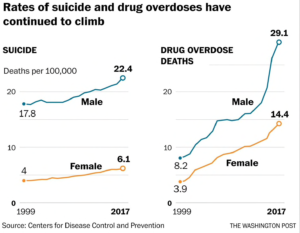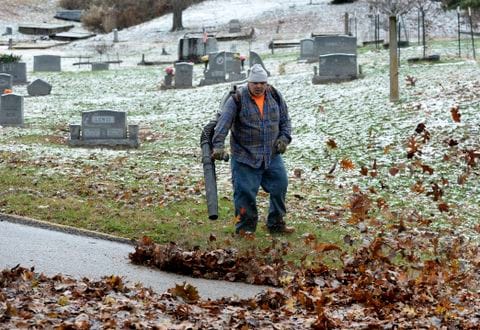By: Lenny Bernstein – washingtonpost.com – November 29, 2018
Life expectancy in the United States declined again in 2017, the government said Thursday in a bleak series of reports that showed a nation still in the grip of escalating drug and suicide crises.
The data continued the longest sustained decline in expected life span at birth in a century, an appalling performance not seen in the United States since 1915 through 1918. That four-year period included World War I and a flu pandemic that killed 675,000 people in the United States and perhaps 50 million worldwide.
Public health and demographic experts reacted with alarm to the release of the Centers for Disease Control and Prevention’s annual statistics, which are considered a reliable barometer of a society’s health. In most developed nations, life expectancy has marched steadily upward for decades.
“I think this is a very dismal picture of health in the United States,” said Joshua M. Sharfstein, vice dean for public health practice and community engagement at the Johns Hopkins Bloomberg School of Public Health. “Life expectancy is improving in many places in the world. It shouldn’t be declining in the United States.”
“After three years of stagnation and decline, what do we do now?” asked S.V. Subramanian, a professor of population health and geography at Harvard’s T.H. Chan School of Public Health. “Do we say this is the new normal? Or can we say this is a tractable problem?”
Overall, Americans could expect to live 78.6 years at birth in 2017, down a tenth of a year from the 2016 estimate, according to the CDC’s National Center for Health Statistics. Men could anticipate a life span of 76.1 years, down a tenth of a year from 2016. Life expectancy for women in 2017 was 81.1 years, unchanged from the previous year.
Drug overdoses set another annual record in 2017, cresting at 70,237 — up from 63,632 the year before, the government said in a companion report. The opioid epidemic continued to take a relentless toll, with 47,600 deaths in 2017 from drugs sold on the street such as fentanyl and heroin, as well as prescription narcotics. That was also a record number, driven largely by an increase in fentanyl deaths.
Since 1999, the number of drug overdose deaths has more than quadrupled. Deaths attributed to opioids were nearly six times greater in 2017 than they were in 1999.
Deaths from legal painkillers did not increase in 2017. There were 14,495 overdose deaths attributed to narcotics such as oxycodone and hydrocodone and 3,194 from methadone, which is used as a painkiller. Those totals were virtually identical to the numbers in 2016. The number of heroin deaths, 15,482, also did not rise from the previous year.
Robert Anderson, chief of the mortality statistics branch at the Center for Health Statistics, said the leveling off of prescription drug deaths may reflect a small impact from efforts in recent years to curb the diversion of legal painkillers to users and dealers on the streets. Those measures include prescription drug monitoring programs that help prevent substance abusers from obtaining multiple prescriptions by “doctor shopping.”
Others noted programs that may also have helped: The overdose antidote naloxone has been made more widely available in many places; Rhode Island has made efforts to educate substance abusers as they leave jail, a time when they are particularly vulnerable to overdose; and Vermont and other states have bolstered treatment programs. States that have expanded their Medicaid programs are also able to offer more treatment for users.

Anderson said provisional data for the first four months of 2018 show a plateau and possibly a small decline in drug overdose deaths.
But Sharfstein, a former secretary of health in Maryland, said the heroin numbers reveal that fentanyl is pushing that drug out of the illicit market in some places.
“The opioid market has been completely taken over by fentanyl,” Sharfstein said.
Indeed, the new data shows that …
[ . . . ]
To see the remainder of this article, click on read more.
Source: U.S. life expectancy declines again, a dismal trend not seen since World War I
 Listen Online
Listen Online Watch Online
Watch Online Find a Station in Your Area
Find a Station in Your Area









 Listen Now
Listen Now Watch Online
Watch Online
